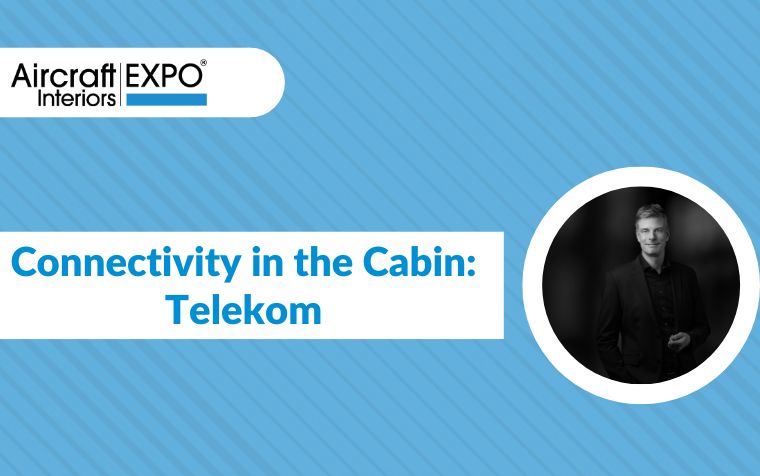The AIX team sat down with aerospace thought-leaders, market disruptors and established companies to discuss how Inflight Entertainment and Connectivity (IFEC) can keep up with changing passenger expectations.
The team spoke with David Fox, Vice President, Inflight & Connectivity Services, Deutsche Telekom.
What are your predictions for connectivity in the cabin in 2023?
“Inflight connectivity is very attractive as it addresses two basic human needs: mobility and communication. Now add a human dream – flying – to these needs, and you easily understand how fascinating inflight connectivity really is. I see three trends of passenger behaviour when looking at the needs for inflight connectivity in the coming year and beyond:
The first is to stayconnected with family & friends.We are all humans and have a basic desire to catch up with family and friends and let them know how we are doing. Sharing special moments via social media channels, messaging or video calling each other has become a pattern, especially good experiences like flying to some exciting holiday destination.
The second is increased digital content consumption. Global online content consumption soared in the “main” pandemic years 2020 and 2021 when consumers spent almost double the time per day engaging with content. Connected TV options (Netflix, Amazon Prime Video, Disney+) and Audio Streaming Apps (Spotify, Deezer, Tidal) were the main beneficiaries of this increase.
Airlines will want to offer these services as well, so their customers can benefit from a rich IFC experience.
The third is increased work-related consumption. With better connectivity on the go, travel times have increasingly become working times. This was initially a big argument for railway services. Now, airlines also want to offer connectivity so they can compete with the existing fast-train city-pair connections. This necessitates a reliable and fast internet connectivity onboard an airplane.
It also further drives the need for remote, work-based applications, for example participating in video conferences (like Zoom, MS Teams), or accessing cloud drives (Google Drive, Dropbox, etc.) and VPN for Mail services.”
How do you see in-flight connectivity evolving in the next five years?
“The technology to enable seamless or near-seamless access to inflight connectivity has been available for quite some time now, but it will only take off once MNOs truly start to bundle the access and make an easy-to-understand proposition available to a large subscriber base.
Offering easy, seamless access to mobile subscribers creates a dramatically improved passenger experience and generates significant value to both airlines and MNOs. However, while passenger Internet access enabled by near-seamless technologies is important, it is only one of many inflight connectivity use cases.
Onboard service offerings such as inflight entertainment, e-commerce and onboard IoT solutions are also contributing to the demand for more connectivity, as we step aboard again in increasing numbers after the airline industry’s gradual but continuous recovery from the pandemic.”
Some estimations have put the “take-rate” for on-board Wi-Fi at just 6%, with some lamenting the poor connection and inability to stream content.
How do you see the role of Wi-Fi changing in the cabin going forward?
“Ease of use and good value are the two main measures by which passengers evaluate inflight connectivity, and there is room for the improvement of both. The current multi-step process of getting online once aboard is still cumbersome and connectivity can be spotty.
To see the role of Wi-Fi changing in the cabin, airlines are therefore in need of creating a unique harmonized passenger experience for all of their connected aircraft. And MNOs need to act and make this last slice of connectivity in the skies readily available to their subscribers as well.
Mobile network operators have taken action to support a harmonized inflight passenger experience on several fronts. A couple of years ago, Deutsche Telekom started to include inflight connectivity as part of its subscriber product portfolio, offering tariffs that include inflight connectivity either bundled-in or as a flat-rate option. Other MNOs have followed.
The availability of the service as part of a bundled product has immediately and positively impacted internet usage aboard.
Another harmonised connectivity service involves airline portals that provide the same gate-to-gate passenger experience to go online no matter what connectivity provider the airline is working with. Deutsche Telekom has partnered with carriers such as Lufthansa and Cathay Pacific to provide such a platform which is seamless and easy for passengers to use – right from the start of their journey until they arrive at their destination.
It provides single-click log-on and “smart-pricing” models that enable airlines to boost Wi-Fi purchases and thus revenues by tailoring offers to the length of the flight. Deutsche Telekom also offers voucher systems and APIs that allow passengers to purchase access before their flight and help airlines to run marketing campaigns.”
The demand to stream content including on short and medium flights has proliferated.
How will airlines ensure they continue to meet this demand?
“Inflight entertainment is especially important to airline passengers to pass the time whilst travelling, and streaming content makes up most of the entertainment services they are looking for. To meet this customer demand, airlines are looking to partner with different vendors who offer streaming services that customers are already used to on the ground.
Airlines also offer specific Wi-Fi packages for streaming to make access to these services as easy as possible for their customer base.”
The EU commission has unveiled plans for airlines to implement 5G technologies onboard for passengers.
Do you see this revolutionising onboard connectivity?
“We consider 5G as next evolution in mobile radio and are aware of the EU commission’s plans. While we are currently focusing on delivering 5G on the ground and are making great progress as one of the industry’s leaders in the development of a 5G ecosystem, we find that the value-add of 5G for use in aircraft is still limited via-a-vis WiFi.
We are not yet seeing demand from the airline sector who needs to evaluate the added cost for their customer base. Also, 5G will be possible for user access via so-called Pico-cells whilst in the air, but the connectivity between ground-based mobile networks and the aircraft itself will continue to be based on satellites.
Subject to market demand and developments, however, we are of course prepared to customize the technology also for aviation use cases, similar as we did for LTE.”
Any other comments or insight you would like to share around the topics of digitalisation and connectivity?
“Our top priorities for the digitalisation and inflight connectivity topics are to first focus on customer centricity for all our product developments. We plan to do that by introducing regular customer experience measures & formats.
Second, we want to harmonize all digital touchpoints and deliver features that ease inflight connectivity for our partners based on APIs to stay flexible and be able to adjust quicker. Last, we are in discussions with our airline customers to develop joint measures for placing digital retail offers.”



